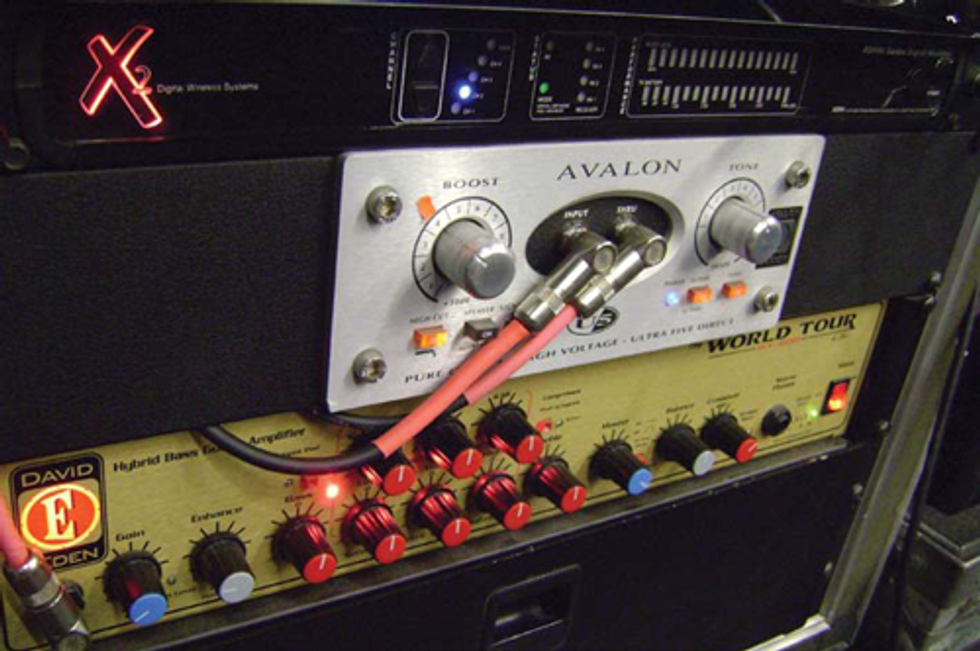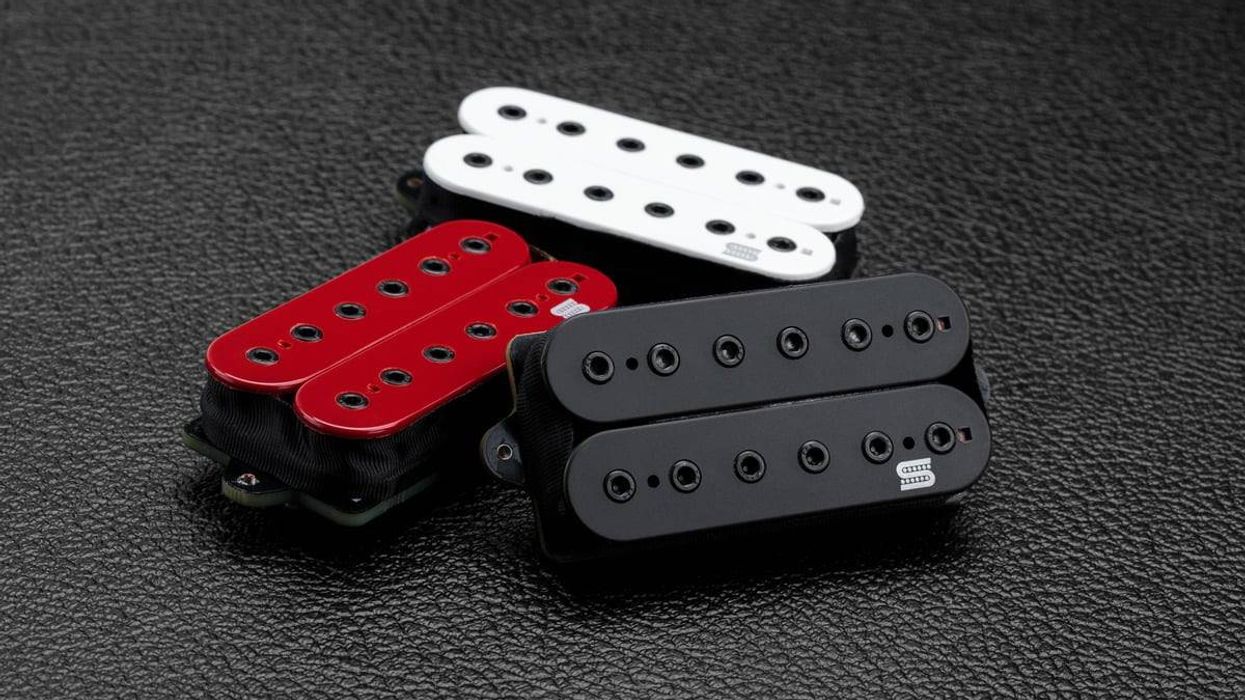Options. The idea of being able to adapt, change, or just have a different path is a comforting notion, and one that is so very important in the never-ending search for great tone. As live players, we search for the best possible tone on stage every night, but are we giving the people out front the best tone possible? What do you do if the tone you like onstage isn’t the best-sounding tone in the house system? What if your ears aren’t hearing the same thing the audience is? How are we supposed to sound good when we’re not out front listening? There is a solution—a happy medium if you will—to getting both a great tone out front and in your ears. It’s about having options.
Bass players generally get neglected by sound engineers at shows. Keeping it simple is important, but too often they run your bass directly into a stock DI, let you do your thing on stage, and be done with it. Do you ever wonder why this is? It’s simple: what sounds good to us onstage may not be the best solution for the overall mix, so the front of house (FOH) engineer gives himself an “out,” a way to shape your sound independently of your adjustments. The bass tone coming directly from your fingers to the PA should sound great, but that isn’t always the case. This means we need to explore other, dare I say, options.

So where to start? First, look at your signal chain. The ideal setup to keep everyone happy is this: your bass plugged into a preamp (which serves as your DI), which is then plugged into your amp. Put a mic on your cabinet as well (more options). Run the DI and mic to FOH, and poof! Instant flexibility. This simple setup allows the engineer to dial in your tone, and you can shape your amp sound independently as needed.
I am on monitor wedges, not in-ears, so my situation is constantly changing. We play different sized rooms every night. The sounds I get from my wedges are the same as what’s going to FOH. I make small adjustments on my amp, depending on the surroundings, and get a nice blend of tone onstage to maintain my comfort level. If you’re on in-ears, then your tone stays the same night after night, so kudos to you for eliminating that problem.
Now we go back to the components of the signal chain. Many modern amps and combos have an XLR out, so why invest in a separate DI? I’m glad you asked. There is the pre/post EQ feature on most amps, giving you the option (there’s that word again) for sending your signal before your tone-shaping modifications hit. This is a simple and great feature, but to me it’s only half the battle. Personally, I think a separate preamp that’s dialed in for FOH and then set in stone is the best alternative. Warming up your signal with a tube preamp is even better. This goes one step further than the bass-to-DI theory, and it allows the signal that is being heard by the audience to be the absolute best it can be. Blending this signal with the mic’d cabinet can bring about some wonderful results. The key to this is working with whoever is running the show out front and dialing it in. If you don’t have a regular engineer working with you, then set the preamp with someone you trust at FOH once, making tiny adjustments as needed from gig to gig. Different engineers will have different ears, but good tone is good tone, no matter who you are.
We were out with a major artist last year, and while awaiting our sound check, I sat and watched the bass player run through his pedalboard, making slight adjustments over and over. It seemed unnecessary and a bit pretentious at the time, and because it was getting late in the day, the crew was getting a little tired of the whole thing. The FOH engineer said to me, “It doesn’t even matter what he does, because what he’s fixing doesn’t even go to the PA.” The whole thing made perfect sense to me. He was getting his tone set in his ears, because the separate signal to the PA was set. The tone you’re comfortable with in your ears may be polar opposite of what the band needs. Let the preamp take care of that for you, and dial in however you want.
I was told a long time ago something very simple and important about a live show. Let the PA do the work for which it was intended. This means we turn up as loud as we need for our tone, and let the mains and monitors do their work. Your rig is not there to fill the room with bass. Your rig is for you. Your tone is for you. You need to maintain a certain comfort level while playing, and having great tone makes that happen. If you’re spending the whole set adjusting knobs, then your mind is not on the music. Get dialed in and ready for the magic, and keep those options open.
See you on the road!
Steve Cook
Steve has performed and recorded with a diverse range of artists, from Edwin McCain to Randy Brecker to Course of Nature. Steve is also an alumnus of Woodstock ‘99, performing with his band King Konga. His current projects include extensive touring and video production with Bucky Covington (Lyric Street) and writing a popular weekly tour journal on his website: shinybass.com.
Bass players generally get neglected by sound engineers at shows. Keeping it simple is important, but too often they run your bass directly into a stock DI, let you do your thing on stage, and be done with it. Do you ever wonder why this is? It’s simple: what sounds good to us onstage may not be the best solution for the overall mix, so the front of house (FOH) engineer gives himself an “out,” a way to shape your sound independently of your adjustments. The bass tone coming directly from your fingers to the PA should sound great, but that isn’t always the case. This means we need to explore other, dare I say, options.

So where to start? First, look at your signal chain. The ideal setup to keep everyone happy is this: your bass plugged into a preamp (which serves as your DI), which is then plugged into your amp. Put a mic on your cabinet as well (more options). Run the DI and mic to FOH, and poof! Instant flexibility. This simple setup allows the engineer to dial in your tone, and you can shape your amp sound independently as needed.
I am on monitor wedges, not in-ears, so my situation is constantly changing. We play different sized rooms every night. The sounds I get from my wedges are the same as what’s going to FOH. I make small adjustments on my amp, depending on the surroundings, and get a nice blend of tone onstage to maintain my comfort level. If you’re on in-ears, then your tone stays the same night after night, so kudos to you for eliminating that problem.
Now we go back to the components of the signal chain. Many modern amps and combos have an XLR out, so why invest in a separate DI? I’m glad you asked. There is the pre/post EQ feature on most amps, giving you the option (there’s that word again) for sending your signal before your tone-shaping modifications hit. This is a simple and great feature, but to me it’s only half the battle. Personally, I think a separate preamp that’s dialed in for FOH and then set in stone is the best alternative. Warming up your signal with a tube preamp is even better. This goes one step further than the bass-to-DI theory, and it allows the signal that is being heard by the audience to be the absolute best it can be. Blending this signal with the mic’d cabinet can bring about some wonderful results. The key to this is working with whoever is running the show out front and dialing it in. If you don’t have a regular engineer working with you, then set the preamp with someone you trust at FOH once, making tiny adjustments as needed from gig to gig. Different engineers will have different ears, but good tone is good tone, no matter who you are.
We were out with a major artist last year, and while awaiting our sound check, I sat and watched the bass player run through his pedalboard, making slight adjustments over and over. It seemed unnecessary and a bit pretentious at the time, and because it was getting late in the day, the crew was getting a little tired of the whole thing. The FOH engineer said to me, “It doesn’t even matter what he does, because what he’s fixing doesn’t even go to the PA.” The whole thing made perfect sense to me. He was getting his tone set in his ears, because the separate signal to the PA was set. The tone you’re comfortable with in your ears may be polar opposite of what the band needs. Let the preamp take care of that for you, and dial in however you want.
I was told a long time ago something very simple and important about a live show. Let the PA do the work for which it was intended. This means we turn up as loud as we need for our tone, and let the mains and monitors do their work. Your rig is not there to fill the room with bass. Your rig is for you. Your tone is for you. You need to maintain a certain comfort level while playing, and having great tone makes that happen. If you’re spending the whole set adjusting knobs, then your mind is not on the music. Get dialed in and ready for the magic, and keep those options open.
See you on the road!
Steve Cook
Steve has performed and recorded with a diverse range of artists, from Edwin McCain to Randy Brecker to Course of Nature. Steve is also an alumnus of Woodstock ‘99, performing with his band King Konga. His current projects include extensive touring and video production with Bucky Covington (Lyric Street) and writing a popular weekly tour journal on his website: shinybass.com.





![Rig Rundown: AFI [2025]](https://www.premierguitar.com/media-library/youtube.jpg?id=62064741&width=1245&height=700&quality=70&coordinates=0%2C0%2C0%2C0)












 Shop Scott's Rig
Shop Scott's Rig















































